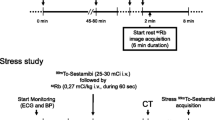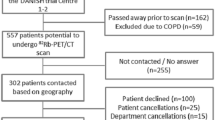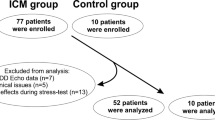Abstract.
Viability studies are often performed in patients receiving beta-blocking agents. However, the intake of beta-blocking agents could influence the identification of viable myocardium when low-dose dobutamine is used to demonstrate inotropic reserve. The aim of this study was to quantify the effect of beta-blockade on global and regional left ventricular function in healthy volunteers using low-dose dobutamine gated single-photon emission tomographic (SPET) myocardial perfusion scintigraphy. Ten subjects were studied once ”on” and once ”off” beta-blocker therapy (metoprolol succinate, 100 mg day–1). On each occasion four consecutive gated SPET acquisitions (of 7 min duration) were recorded after injection of 925 MBq technetium-99m tetrofosmin on a triple-headed camera equipped with focussing (Cardiofocal) collimators. Acquisitions were made at rest (baseline 1 and 2) and 5 min after the beginning of the infusion of 5 and 10 µg kg–1 min–1 dobutamine. Wall thickening (WT) was quantified using a method based on circumferential profile analysis. Left ventricular ejection fraction (LVEF) was obtained using the Cedars-Sinai algorithm. Blood pressure (BP) and heart rate (HR) were recorded at the end of each acquisition. At baseline LVEF, WT and systolic BP values under beta-blockade were not significantly different from those obtained in the non-beta-blocked state. The mean HR and diastolic BP at baseline were lower under beta-blockade. Dobutamine administration (at 5 and 10 µg kg–1 min–1) induced a significant increase in WT, LVEF and systolic BP in all subjects both on and off beta-blockade. The increases in WT, LVEF and systolic BP in the beta-blocked state were less pronounced but not significantly different. HR increased significantly at 10 µg kg–1 min–1 dobutamine without beta-blocker administration, while no increase in HR was observed in the beta-blocked state. Beta-blocker therapy in healthy subjects attenuates the inotropic and chronotropic myocardial response to low-dose dobutamine. At doses of 5 and 10 µg kg–1 min–1 dobutamine, however, significant increases in global and regional left ventricular function can still be measured using consecutive gated SPET myocardial perfusion scintigraphy acquisitions even under beta-blocker therapy.
Similar content being viewed by others
Author information
Authors and Affiliations
Additional information
Received 4 September and in revised form 3 November 1999
Rights and permissions
About this article
Cite this article
Everaert, H., Vanhove, C. & Franken, P. Effect of beta-blockade on low-dose dobutamine-induced changes in left ventricular function in healthy volunteers: assessment by gated SPET myocardial perfusion scintigraphy. Eur J Nucl Med 27, 419–424 (2000). https://doi.org/10.1007/s002590050525
Issue Date:
DOI: https://doi.org/10.1007/s002590050525




